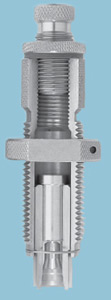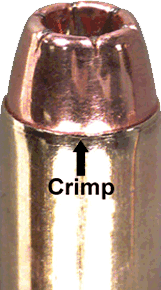Home | Glossary | Resources | Help | Contact Us | Course Map
Archival Notice
This is an archive page that is no longer being updated. It may contain outdated information and links may no longer function as originally intended.
Assembly
All ammunition assembly requires
- priming the cartridge case (except rimfire - already primed ahead of time),
- charging the cartridge case with propellant,
- inserting the bullet or shot/wad charge,
- crimping and/or sealing,
- testing and inspection.
The cartridge assembly process depends on the cartridge class (rimfire, centerfire, and shotshell) and the type of machinery used.
See the YouTube Terms of Service and Google Privacy Policy
Rimfire
At this stage of assembly, the rimfire case is primed and ready for the loading of a propellant charge.
Charging with Propellant
Regardless of cartridge class, charging with propellant requires great control over the amount placed in each case. Too little propellant and the bullet may stick in the gun barrel; too much and the case could fail, injuring the shooter or damaging the firearm. This problem is compounded due to the small amount of propellant required for rimfire ammunition. Important factors to be considered when measuring rimfire charges are grain size and shape.
Propellants are metered by volume because there is no feasible method of weighing each charge while meeting production demands. Volumetric metering of granulated materials in a production environment requires the ability to produce consistent charges throughout the run. Various methods are used, depending on the loading equipment.
After charging, the cases are inspected for uniform propellant levels. This is the last point in production where it is possible to inspect for the presence of a charge.
Bullet Seating
Rimfire bullets have the same diameter as the outside of the cartridge case. For the bullet to hold in the case, its base section is smaller to match the inside case diameter. The most common rimfire bullets are found in .22 Short, .22 Long, and .22 Long Rifle ammunition. The common term for this style is heeled bullet.
In the bullet-seating operation, the cases are held on either a continuous conveyor mechanism or in plates holding hundreds of cases. If the conveyor system is used, an alignment die falls lightly on each cartridge mouth and a bullet is fed into the die. Shaped to match the bullet tip, a seating punch presses the bullet into the case, resulting in a friction fit.
If the plate-loading system is used, cases are held in one plate and bullets in another. The upper plate serves the same purpose as the alignment die. The two plates are aligned and placed in a seating press. The ram of the press is fitted with a seating pin for each case, and all bullets are seated in one stroke.
Crimping
Crimping is the folding or bending of the case mouth to grip the bullet. For conventional bullets, this is a relatively simple operation because the case diameter is larger than the bullet diameter. A simple die with an internal shoulder can form the crimp quickly.
This is not possible for rimfire bullets; a rotary crimper is used instead. Loaded cartridges fall onto a plate and are driven against a rotating steel wheel with protrusions that roll the crimp into the case and bullet at the correct location. Simultaneously, any cannelures (for the purpose of retaining lubrication) are rolled. For additional weatherproofing, a knife cut may be used to force lead onto the new crimp; this is also performed on the rotary crimper.
Lubrication is added to lead bullets to reduce bore fouling. Rimfire bullets can be prelubricated or lubricant can be added after the cartridge is loaded. The final steps are testing, inspection, and packaging of the loaded cartridges.
Additional Online Courses
- What Every First Responding Officer Should Know About DNA Evidence
- Collecting DNA Evidence at Property Crime Scenes
- DNA – A Prosecutor’s Practice Notebook
- Crime Scene and DNA Basics
- Laboratory Safety Programs
- DNA Amplification
- Population Genetics and Statistics
- Non-STR DNA Markers: SNPs, Y-STRs, LCN and mtDNA
- Firearms Examiner Training
- Forensic DNA Education for Law Enforcement Decisionmakers
- What Every Investigator and Evidence Technician Should Know About DNA Evidence
- Principles of Forensic DNA for Officers of the Court
- Law 101: Legal Guide for the Forensic Expert
- Laboratory Orientation and Testing of Body Fluids and Tissues
- DNA Extraction and Quantitation
- STR Data Analysis and Interpretation
- Communication Skills, Report Writing, and Courtroom Testimony
- Español for Law Enforcement
- Amplified DNA Product Separation for Forensic Analysts



